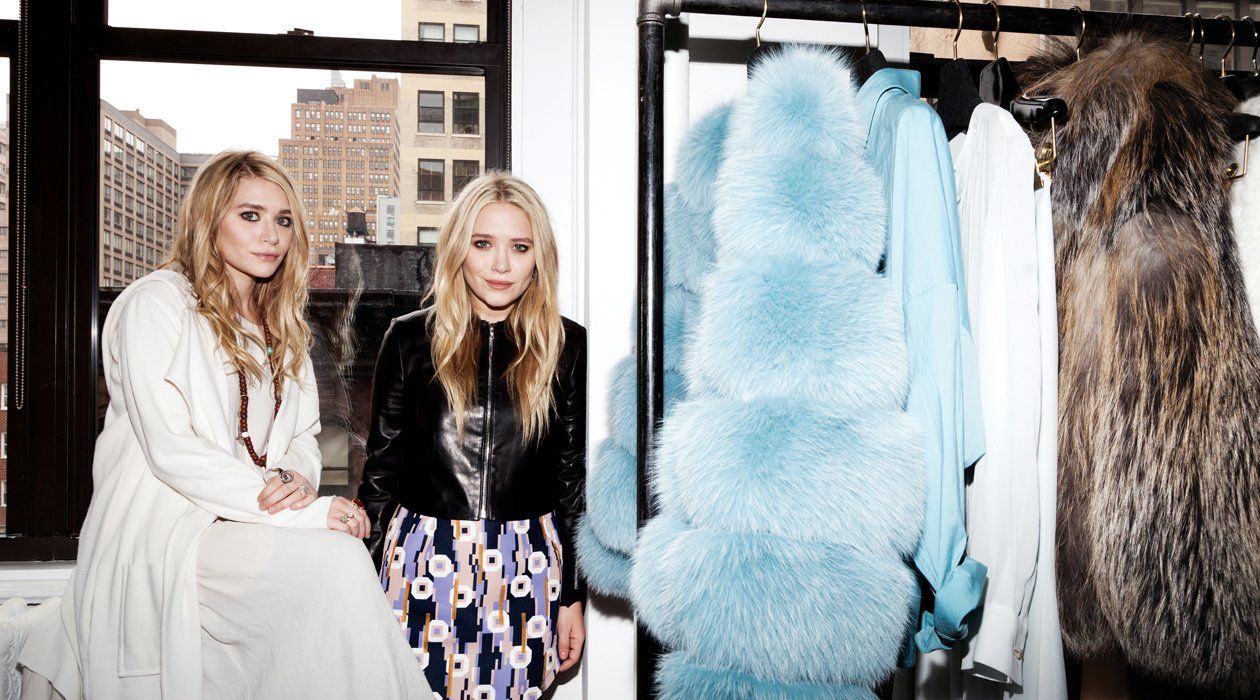
Mary-Kate and Ashley Olsen, whom most people know as the diminutive former child stars of Full House and an endless stream of straight-to-video tween movies, are inspecting a rolling rack of crisp white cotton shirts and another one lined with black stretch-leather leggings seemingly sized for miniature gazelles. The sisters and the clothes are crowded onto an exceedingly unglamorous factory floor in New York's garment center. The L-shaped workspace, brightly lit with fluorescent lights, smells vaguely of steam irons and fried rice.
This is the Olsens' new reality, one that has replaced a childhood lived on Hollywood backlots and an adolescence spent in the glare of the paparazzi. They built a billion-dollar empire on the cult of celebrity, adoring kiddie fans, and a vast array of tchotchkes. Now they are creating something else entirely. Against significant odds, the Olsens have found grown-up respectability and social purpose in the unforgiving world of high-end fashion with the success of their womenswear brand, The Row.
The collection—embraced by older women with little patience for celebrity frippery—has been worn by business executives and first lady Michelle Obama.
Critical validation has come in the form of a nomination from the Council of Fashion Designers of America as the year's best new womenswear designers. They have been recognized alongside Joseph Altuzarra, who worked at Givenchy, and Prabal Gurung, a Bill Blass alumnus. The winners will be announced in New York on June 6.
The Olsens, who will be 25 in June, did not go to fashion or art school. They have built a considerable reputation by obsessing over darts (they hate them), gamely absorbing the blows of skeptical retailers, and keeping their celebrity mostly under wraps. They also have become champions in a longstanding effort to save this country's garment factories. In 1965, factories in America produced 95 percent of the clothes sold in this country, according to savethegarmentcenter.org. Today, only 5 percent of the clothes sold here are produced locally. The future of New York's garment center is no longer in mass production, activists argue, but rather in small-scale, high-end manufacturing that relies on skilled artisans.
"The whole point is reinvention—not what it was, but what it can be," says designer Yeohlee Teng, who has been a leader in the effort.
The Olsens have taken up this blue-collar cause by producing their collection in factories in New York and, to a lesser degree, Los Angeles. (Their handbags are produced in Italy, as are a few of their superfine knits.)
"I really believe in our being able to create here and utilize the skills that people have here," says Ashley. "The skill set is here. Our main issue is that some of the machinery is gone, so some knitwear is produced in Italy. But whether it's clothing or cars, I believe in manufacturing as close to home as possible."
It was late one drizzly morning in April when the Olsens offered a tour of their factories. We'd climbed into a black GMC Yukon, with tinted windows and a driver who looked vaguely like Chris Daughtry, for the short ride from their headquarters in Chelsea to the garment center. Mary-Kate, sitting in back, wore a black leather jacket and blouse from The Row, along with a geometric-print miniskirt. Ashley, riding shotgun, was swaddled in long layers from The Row—a double-face cashmere coat, a loose-fitting ivory dress, an ivory vest. Their long blonde hair was pleasantly tousled.
It's tempting to refer to the twins, who live separately in New York, as "girls" because they are so tiny, even in what appear to be four-inch heels. But when you look at them, really look at them instead of just glancing at the big round eyes and the angular contours of their famous faces, you realize that any sense of little-girl "cute" is long gone.
Their holding company, Dualstar Entertainment Group, was created with their then-manager, Robert Thorne, when they were about 6 years old as a vehicle for selling Olsen-branded merchandise and projects. By age 10, they had a line of clothing in Walmart; eventually they branched out with a contemporary line called Elizabeth & James, named after their siblings. At 18, they took over Dualstar, buying out Thorne. "Thank God our parents wanted us to be involved," Ashley says. "Running a fashion company, it's just as important to understand numbers as it is to have a design point of view," Mary-Kate says. The company now has annual sales of $1 billion, according to Forbes.
For years, Dualstar's main purpose was essentially promoting the sisters themselves: their celebrity and the buzz that surrounded them. The arrangement transformed them into teenage millionaires.
As students at New York University, their image shifted from squeaky-clean TV kids to young women grappling with serious issues, such as Mary-Kate's eating disorder, under the gaze of the public.
Today they are chief executive officers of Dualstar. And along with company president Jill Collage, who runs day-to-day operations, the Olsens hold sway over its growth and direction. The emphasis has shifted from branding to focusing on product—from The Row's partnership with TOMS Shoes to the launch of an online subscription shopping service called Stylemint.
The lobby of the high-rise that houses their factories is overseen by a chipper fellow named Willie, who goes giddy at the sight of the Olsens. Without Willie, a visitor would be lost. Signage is limited and uninformative. While some designers are willing to share the information about their resources, the Olsens are secretive. Indeed, as the owner of the 40-year-old leather factory—a silver-haired, old-school rocker—displays a length of stretch python, the Olsens whisk it away before it can be photographed.
The factories are filled with the quiet intensity of men and women engaged in precise work. And the owner of the shirt factory, who emigrated from Guyana, tells me he's expanding because of the business the Olsens have brought him.
The Row, founded in 2006 and named after Savile Row, began with Ashley's search for a perfect white T shirt: fashion's holy grail of fit, comfort, durability, and price. She was dissatisfied with what was available, and a business was born. That first collection consisted of jersey T shirts and knit leggings. It evolved into a line of intricately woven fox jackets, cashmere sweaters, wool and mohair dresses, and leather leggings for which women are willing to pay $1,700.
The Row might best be described as the Gap meets Jil Sander: basic, minimal, adult, and extremely expensive. A jersey T shirt: $290. A cashmere and mink sweater: $5,900. And for fall, while "debt" and "unemployment" are on the tip of everyone's tongue, the Olsens have introduced more fur, more cashmere, raising their overall prices by as much as 25 percent.
Their customers can afford it. While most designers thrill to say their core shopper is a 25-year-old woman, The Row's main customer is 35 to 45 years old. Instead of encouraging women to cling to their slacker years, the Olsens want them to luxuriate in their most productive ones. That point of view is rare. Most young designers create collections for their contemporaries—or some fairy-tale version of them. And even as designers grow older, they tend to shift their focus to women who are their junior. The Olsens seem to revel in the promise of maturity. Their work avoids high-society, leisure-class clichés. Instead, it evokes a professional, tailored, hail-a-cab-in-the-rain reality.
Sold at such stores as Barneys New York and small, independent boutiques, The Row's sales are estimated at $10 million to $12 million annually.
To reach this point, the Olsens cleared the enormous hurdle of being a celebrity brand in a sector of the industry that had grown to view them with derision. "I am always skeptical of celebrity lines," says Julie Gilhart, the former fashion director of Barneys New York, who saw The Row when it debuted and embraced it. "I was definitely hesitant before going to the first appointment."
Instead of trying to leverage their fame, the Olsens hid it—most notably by not putting their name on the label. "Initially, I wanted someone else to front the brand," Mary-Kate says. "We wanted someone else to rep it. But we couldn't lie."
Retailers did grill them: Where were the clothes made? Why were they so damn expensive? "With the retailers, we dealt with some tough cookies," Ashley says. "Their attitude was, 'Who do these girls think they are?'?"
"It definitely took time to earn people's respect," Mary-Kate says.
There were holdouts. Nancy Pearlstein, who owns Relish in Georgetown, looked at the collection three separate times. She kept hearing raves from other retailers, but ultimately couldn't justify the prices. Yet even to get a return visit from the likes of Pearlstein meant a barrier had been breached.
"What they do has become successful, and everyone needs to give them that," Gilhart says. "They really concentrated on product, not fashion so much. Their pieces fit into the trends yet weren't trendy."
In their showroom, which is in the offices of Dualstar, the Olsens do business around a banquet-size table decorated with a bouquet of white roses and lilies. Ashley tends to zero in on the technical aspects of the collection. Mary-Kate is more likely to highlight pure aesthetics. Both, however, are adamant about what they want the collection to be. "We really want The Row to be an American luxury brand," Ashley says. "We believe in not just American by representation but American by make."
To that end, the Olsens traveled to Washington last year, where they lobbied the East Wing on the importance of the garment center: fashion provides New York with 28 percent of its manufacturing jobs. It puts $10 billion annually into New York's economy.
Who knows, muses Teng, who was also at the White House, the next time the first lady wears a dress by an American brand, she might also make a point of saying it was made in America.
In the meantime, the Olsens apparently have already won Mrs. Obama's respect in a very public way. She wore their pleated skirt when she appeared in April on The View.
Uncommon Knowledge
Newsweek is committed to challenging conventional wisdom and finding connections in the search for common ground.
Newsweek is committed to challenging conventional wisdom and finding connections in the search for common ground.
About the writer
To read how Newsweek uses AI as a newsroom tool, Click here.





